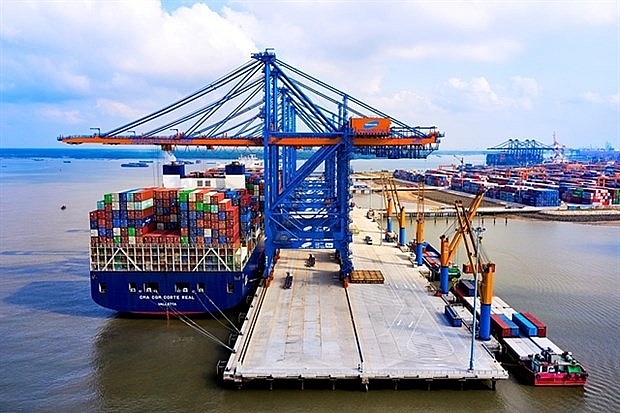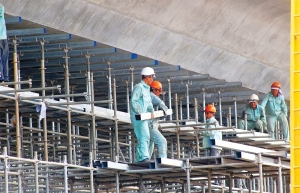Economic momentum softens heading into 2024
In its latest report on global economic prospects released over a week ago, the World Bank predicted that in 2023, lacklustre growth in the global goods trade, which is a key engine of East Asia and Pacific in recent decades, is expected to weigh on activity, particularly in Vietnam where growth is projected to moderate.
 |
| Containers at Gemalink International Port in Ba Ria-Vung Tau Province. (Photo: VNA) |
The bank has lowered Vietnam’s economic growth for 2023 from 6.3 per cent in its January forecast to 6 per cent this year, 6.2 per cent in 2024, and 6.5 per cent in 2025.
However, these rates are the highest in Southeast Asia, with the growth rate in 2023 being 5.5 per cent for Cambodia, 4.9 per cent for Indonesia, 4.3 per cent for Malaysia, and 3.9 per cent for both Laos and Thailand.
“The Vietnamese economy is facing external headwinds as weakening external demand weighs on exports, translating into weak industrial production. While domestic consumption remains robust, credit growth slowed, reflecting weak credit demand,” the World Bank said in its May bulletin on the Vietnamese economic performance.
According to the Vietnamese General Statistics Office, Vietnam’s index for industrial production (IIP) in the first five months of this year dropped 2 per cent compared to the same period last year, when the IIP climbed 8.1 per cent on-year.
The IIP for the processing and manufacturing sector declined 2.5 per cent against the corresponding period last year, when it rose 8.9 per cent on-year. The electricity production and distribution sector climbed only 0.8 per cent on-year, while the mining sector fell 3.5 per cent on-year, and the water supply, wastewater, and waste management and treatment sector expanded 6.4 per cent.
Spanish global analysts FocusEconomics told VIR that in Vietnam, economic momentum will soften this year due to slower growth in private consumption, fixed investment, and exports.
“That said, stronger fiscal spending would add support, and Vietnam would remain among ASEAN’s top performers,” FocusEconomics said. “Foreign exchange fluctuations, monetary policy, relations with the US, and the impact of China’s recovery on exports are key factors to watch.”
The analysts forecast Vietnam’s GDP to expand to 5.4 per cent in 2023, down by 0.3 percentage points from the firm’s forecast made one month ago, and increase to 6.5 per cent in 2024.
After sliding 11.2 per cent on-year in April, industrial output rose 0.1 per cent on-year in May. This still signals a worsening trend in the industrial sector.
FocusEconomics sees industrial production expanding 5 per cent in 2023, down by 2.5 percentage points from one month ago, and climbing to 8.8 per cent in 2024.
Prompted by economic woes, the International Monetary Fund has also lowered its projection for Vietnam’s growth from 6.2 per cent in January to 5.8 per cent for this year and 6.9 per cent for next year. Despite the revision, this will still be among the highest in the emerging and developing Asia group of 30 economies.
At the National Assembly, Minister of Planning and Investment Nguyen Chi Dung said, “The crucial thing for enterprises is that they must have orders as soon as possible because orders will help them boost production and business activities. However, they are facing numerous burdensome administrative procedures. Many businesses are lamenting that such procedures in many localities are very slow as state cadres don’t want to work, and instead shirk responsibility.”
According to the World Bank, one of the biggest drivers for economic growth in Vietnam is to boost public investment.
“Acceleration of public investment disbursement could support aggregate demand and economic growth in the short run while ensuring investments in human capital and resilient and green infrastructure will bolster long term economic development,” the bank said
Vietnam’s GDP grew 8.02 per cent last year, the highest in 10 years, while total per capita income hit $4,110.
| Looking ahead, we think that headwinds to the property sector will remain significant amid a broader slowdown in the economy and rising costs of financing. We forecast Vietnam’s real GDP growth to slow from 8.02 per cent in 2022 to 6.5 per cent in 2023, and we expect the State Bank of Vietnam to hike its benchmark policy rate by 100 basis points in 2023. The challenging outlook for real estate will, in turn, weigh on Vietnam’s banking prospects. Official estimates suggest that around one-fifth of the banking sector’s loans are owed by the property sector. While Vietnam’s non-performing loan ratio has remained low, at generally less than 2 per cent since 2018, we think that it could rise to as high as 2.5-3 per cent in 2023. Lastly, the banking sector’s capital adequacy is difficult to ascertain and is probably overstated. The latest available data from the International Monetary Fund showed that the banking sector’s regulatory capital to risk weighted assets ratio stood at 11.3 per cent at end-2021, slightly above the minimum regulatory capital adequacy requirement of 9 per cent. However, the data is impaired by the fact that many banks were not reporting in line with Basel II requirements back then. A growing number of banks have been gradually adopting the more stringent Basel II standards ever since. We expect the data to soon reflect the weakening picture of Vietnam’s banking capitalisation levels.Source: Fitch Solutions. |
 | ASEAN, Eurasian Economic Union hold business dialogue A business dialogue between ASEAN and the Eurasian Economic Union (EAEU) was held on June 15 in the framework of the 26th St. Petersburg International Economic Forum (SPIEF) in Russia. |
 | Public investment deemed key driver for economic growth and inflation control Rebounds in retail and consumption services and in the disbursement of public investment are expected to put pressure on the country’s efforts to bring inflation under control this year. |
What the stars mean:
★ Poor ★ ★ Promising ★★★ Good ★★★★ Very good ★★★★★ Exceptional
Related Contents
Latest News
More News
- Global partnerships key to Vietnam’s IFC development (December 26, 2025 | 16:18)
- Vingroup pulls out of bid to invest in North-South high-speed railway (December 26, 2025 | 11:42)
- Strengthening supply chains through trade promotions and customs reform (December 24, 2025 | 14:00)
- PM orders investment model for North–South high-speed rail (December 22, 2025 | 17:43)
- LS Eco Energy to invest in Vietnam rare earth sector (December 22, 2025 | 17:31)
- Government moves to establish International Financial Centre (December 21, 2025 | 21:00)
- Vietnam's IFC to target global investment flows (December 21, 2025 | 18:00)
- Two national hospitals expand capacity with new facilities (December 20, 2025 | 09:00)
- Ha Tinh breaks ground on major Vingroup industrial and energy projects (December 19, 2025 | 18:24)
- EVN launches major power infrastructure projects nationwide (December 19, 2025 | 18:17)

 Tag:
Tag:





















 Mobile Version
Mobile Version